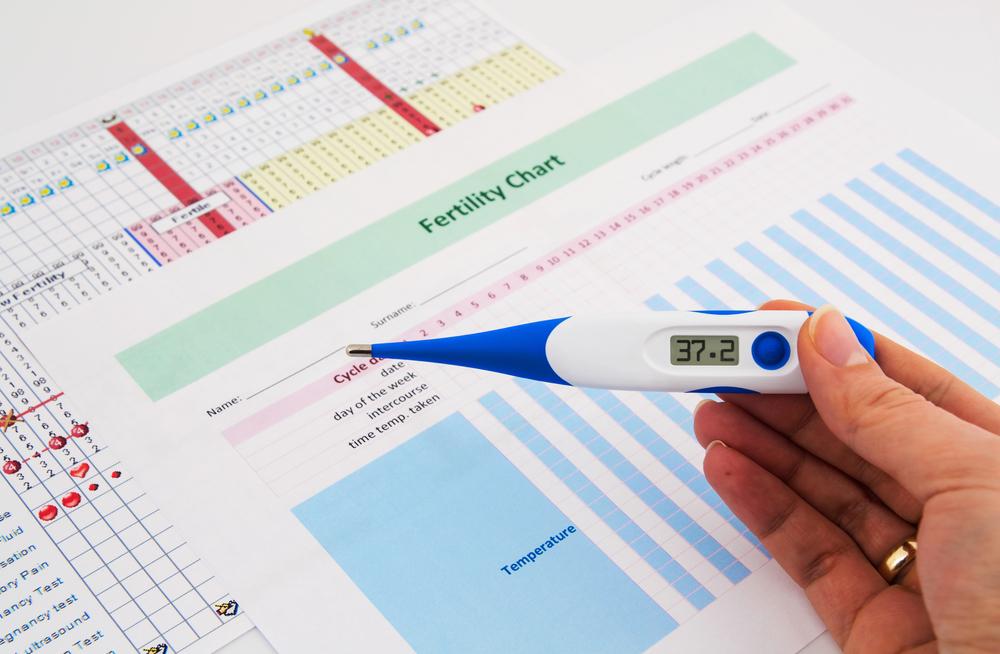We all know people who decide to stop using birth control, just let things happen naturally, and are pregnant two weeks later. I wish I could say I approached getting pregnant with this relaxed attitude. In reality, I came to it with the grim determination of someone training for a marathon. Yeah, there might be some endorphins along the way, but basically we’re just going for the finish line.
Consistent with how I’d approach any goal-oriented activity, I wanted to make sure I was doing everything I could to accomplish the task. So I started taking my temperature every morning. This is an old technique for charting fertility; it relies on the fact that morning body temperature is slightly higher in the second half of the menstrual cycle, after ovulation, than the first half. By recording temperatures, you can in principle learn which days of the month are most fertile for you.
In the books I read, the temperature charts looked beautiful: low temperatures at the start of the month, a huge increase one day, and then high temperatures the rest of the month. My charts, in contrast, looked like a kindergarten art project. I eventually did get pregnant, but no thanks to the thermometer. When I then sat down a few months later to write Expecting Better, I wondered whether I was the only one who couldn’t get this right.
There are three commonly used methods for detecting ovulation: charting your temperature, checking your cervical mucus, and (slightly higher tech) peeing onto one of those ovulation tracker sticks. You can, of course, combine these techniques, and naturally there is an app for that. In principle, all three approaches work. The question is how they work in practice for the average woman.
We can learn something about this from a study that appeared in the journal Fertility and Sterility in the late 1990s. Women in the study used these fertility-charting methods, and researchers also detected the actual day of ovulation with ultrasound.
The temperature charting method did OK, but I wasn’t alone in finding it not perfect. As used by the women in the study, it accurately identified the day of ovulation about 30 percent of the time. Another 30 percent of the time this method pointed to ovulation one day before it actually occurred. The day-before ovulation is also a good time for getting pregnant, so if you had sex on the date indicated by the temperature charting, 60 percent of the time you would manage to time sex on one of your two most fertile days of the month.
Results for the second technique, checking the quality of cervical mucus (which, when you are ovulating, is clear and stretchy—it’s often called “egg white mucus”), were about as good. In this same study, checking mucus detected the date of ovulation 50 percent of the time. In another study with a similar design, but focused only on cervical mucus, this technique identified the day of ovulation in about 34 percent of cases and the day before ovulation in another 25 percent of cases.
Finally, we arrive at the ovulation pee sticks. These work great. In the Fertility and Sterility study they detected ovulation 100 percent of the time. The downside, of course, is that they are expensive.
So, how big a deal is it to detect ovulation? Answer: It matters. From very detailed data on couples—including exactly when they had sex and whether they conceived—we know that pregnancy is only possible in the five or six days leading up to and including ovulation. This suggests that you’ve got to get the timing right, and if you do, the odds are pretty good. Pregnancy rates are 30 percent for sex on the day before or day of ovulation, versus 10 percent five days before. No one in the aforementioned study got pregnant having sex more than five days before ovulation.
So should you lay back and leave your pregnancy to chance, or track, measure, and chart? Depends on your time frame, I suppose. But done right, if you want to have the best shot at getting pregnant, shell out for the pee sticks.
